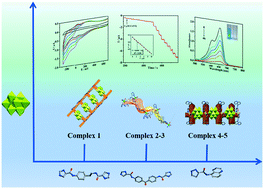Various amide-derived ligands induced five octamolybdate-based metal–organic complexes: synthesis, structure, electrochemical sensing and photocatalytic properties†
Abstract
By designing and introducing three new amide-derived ligands, {L1 = 4-[(1H-imidazole-4-carboxamide)ethyl]phenyl-1H-imidazole-4-carboxamide, L2 = bis[4-(1H-imidazole-4-carboxamide)phenyl]methanone and L3 = N-(quinolin-5-yl)-1H-pyrazole-3-carboxamide}, into the reaction system based on different metal ions and polymolybdate, five octamolybdate-based complexes, [CoL1(β-Mo8O26)0.5] (1), [M(H2O)2L2(β-Mo8O26)0.5][M = Co (2) and Ni (3)] and [M(HL3)2(β-Mo8O26)][M = Co (4) and Zn (5)], have been successfully prepared and structurally characterized. The three ligands were designed and used for the construction of polyoxometalated-based metal–organic complexes for the first time. Complexes 1–5 show 2D supramolecular structures, and their remarkable structural feature is that the coordination between metal ions, octamolybdate and organic ligands generated diverse architectural segments. A 1D ladder-like chain in complex 1 was formed by using the L1 ligand, where the Co–L1 metal–organic chain acted as the “sides” of the ladder and the polyoxoanion acts as the “middle rails”, but a 1D wave-like metal–organic M–L2 chain for the L2 ligand in 2 and 3, and a 1D fence type chain for the L3 ligand in 4 and 5 were formed. In addition, the effect of amide-derived ligands on the final structures of the title complexes was discussed. The electrocatalytic and electrochemical sensing towards bromate, nitrite, Cr(VI) and Fe(III) ions, as well as the photocatalytic activities for organic dyes of the title complexes were also investigated. Complexes 1 and 5 exhibit remarkable current responses in the determination of trace Cr(VI) and Fe(III) ions, and complex 5 displays a superior lower detection limit, which can reach 0.7 μM.

- This article is part of the themed collection: Coordination Networks


 Please wait while we load your content...
Please wait while we load your content...